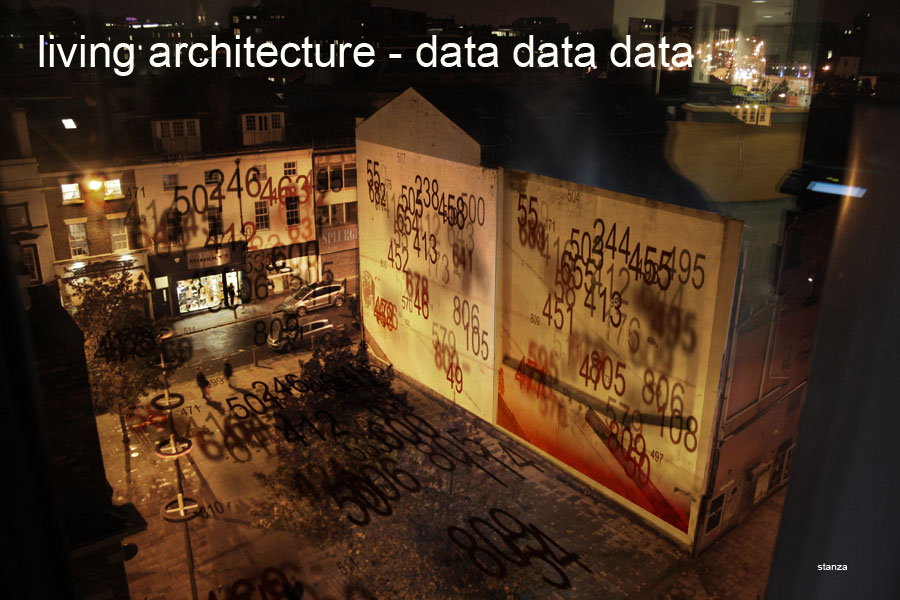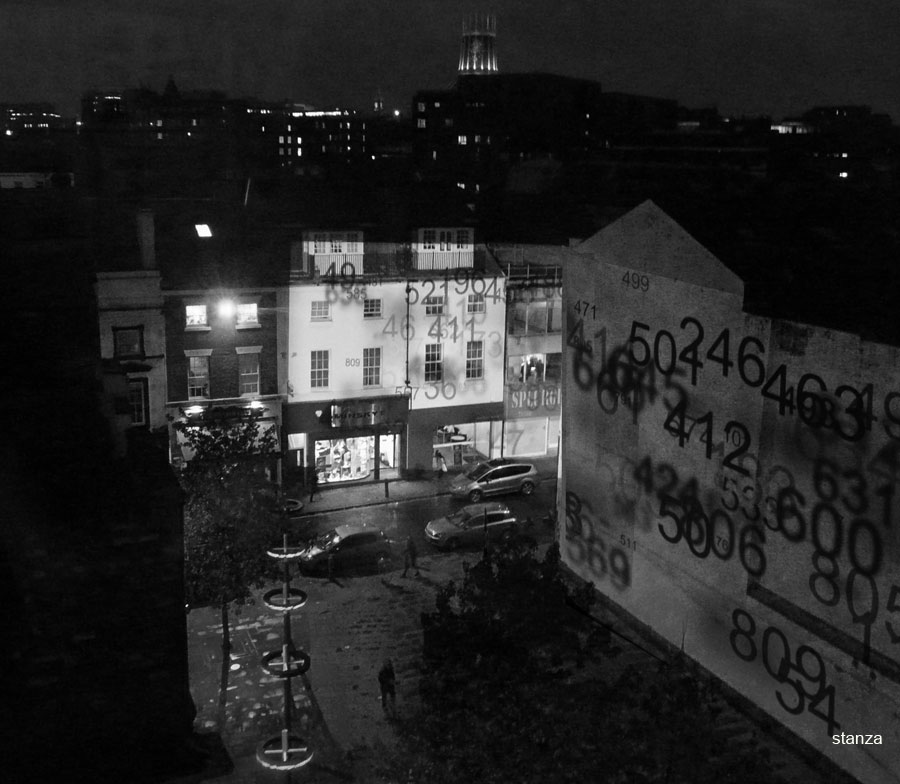
Artwork. Title 'Data Data Data'. 2010
This urban spectacle makes the invisible visible. 'Data Data Data' by Stanza is a live, real time data visualisation of the connected city space. This is an art project that re distributes information about the fabric of our cities opening out the notion that the wider city is in effect a large controlled space. This artwork is made using smart sensors which are scattered over the city. The artists multi sensor network and custom software responds to changes within the urban space and the continuous stream of data is projected back over the city. By embedding the sensors like this we can re-engage with the urban fabric and enable new artistic metaphors within city space. The artwork which is constantly changing is then projected outside across the city in this case Ropewalks Square, Liverpool from a projector sited at FACT. The city is explored in terms of the surveyed and monitored landscape as a liquid flowing data space, demonstrating specifically how insights through the development of the distributed mesh sensors across the city led to online real-time data visualisations.
The digital media installtion allows a critical reflection on the ownership and creative use of environmental data (light, temperature, noise, sounds, GPS, humidity) within larger systems that seek to disclose invisible patterns and behaviours, unfolding these data changes in real-time. The idea here was to give tangible form to this new space, the space where the data environments can overlap, thus presenting an alternative urban virtual environment, a visual layer of the real-time city that is experienced by an online audience. The interface facilitates remediation of this data by linking up the virtual spaces as a series of layers across distances. here the audience sees the data made visible as a morphing series of numbers back out across the city.
The digital artwork is informed by methods and processes of live data collection that sought to conceive of new ways to represent city environments using novel ad hoc sensor deployment. The stated aim was to mediate real-time data into digital artworks which respond to the ‘city' and its concurrent, measurable sensory 'behaviours'. A series of aims were defined, which focused on access and analysis of the available data relating to urban spaces. The practice involved developing new artistic representational forms of city environments using real-time data collection techniques, using sensors to explore how these approaches reveal the city as a system of normally invisible hidden phenomena and systems. Finally, the resulting artworks is presented via online networks creating new bespoke systems and platforms, also creating a commonly owned data platform.
The artistic proposition made is that this specific virtual space belongs to us all as public domain space, and the data can, therefore, become commonly owned. Thus, the suggestion is that these data are, in fact, currency and the project distributes this value freely, even if it is only cultural.
This project engages with the city as a system of layered information flows. In this context, given that the urban environment is a good model for the complex interactions and relations seen as governing our world. The artworks are developed and sited and experienced on the internet. This creates a new novel narrative inside this new virtual space, and as data-cities merge they overlap one another and can become interrogated by new questions searching for new knowledge. By focusing on the open online visualisation of the city as a data-space the focus can shift away from this 'promise' because, as Stanza suggests, one cannot avoid mentioning the control and the ethics of data being manipulated, which is central to this project. This now positions this practice and these new media artworks in relation to the ethics and ownership of data and investigates the city as panopticon.
Context. Making art with environmental data.
The old analogue world of modernism was a world of fluids and gases atoms and molecules. This 'new' digital world is now a world of numbers. Zeros ands ones make up the fabric of our space and experiences. As we move about our interactivity affects the ever changing environment and these changes are reflected back in this real time artwork.
Stanzas work for Liverpool was a playful provocation and re-invention of Ropewalks Square in front of FACT, in effect, ‘reclaiming the streets’ through a fascination with data aesthetics in its purest form as information. Linking these interests is a strong personal motivation to reveal structure driven through a strong sense of social justice reflecting working class roots, ‘re-claiming the streets’. Perhaps now as hegemonies and hierarchies appear on the edge of collapse, the recent work is a timely navigation with young people in considering our re-instatement as individuals in a landscape both virtual and material. A reclamation of rights, public space and identity. “ who considers himself the legitimate basis of truth by virtue of what is supposed to be immediately given for him, obeys the web of delusion of a society that falsely but necessarily thinks of itself as individualistic.” [1] Theodor W. Adorno, Hegel: Three Studies, trans. Shierry Weber Nicholsen (Cambridge, MA: MIT Press, 1993), 63. Mike Stubbs, Director of FACT
Technical note
This technology can work locally as well as online over the internet to represent space as numbers but the sensors have to be switched on. Custom software made now enables these sensors to communicate with one another in a network over a proxy server in real time. Two networks of over forty sensors which collect this data to make the artwork have been developed.
Exhibition.
The equipment is portable and can be set up to make a visualisation and sonification of any location on a commission basis. Contact me if your interested in exhibiting this.
Keywords: data visualisation, net art, techno, sensors, artwork,

The data is broadcast back across the city 2010. |